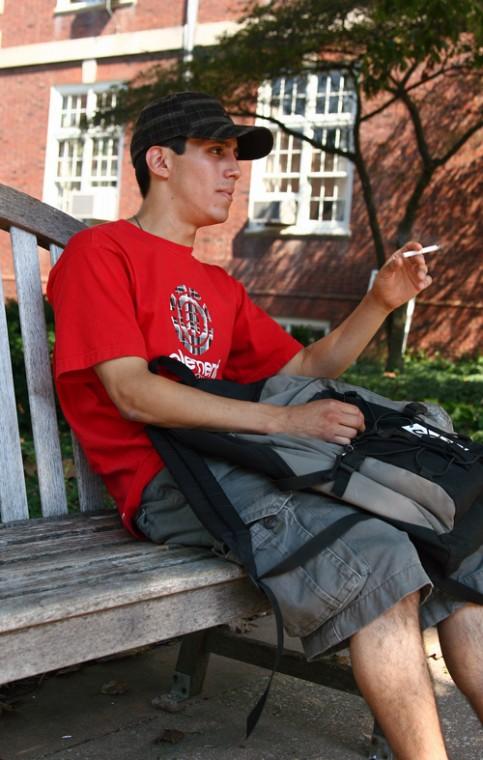College smoking at lowest level since 1980, according to new study
Sep 24, 2008
Last updated on May 13, 2016 at 02:22 p.m.
One in five college students smoke, the lowest rate among that age group since 1980, according to a study released by the American Lung Association in early September.
The 19.2 percent smoking rate is lower than the highest ever rate of 30.6 percent of students smoking in 1999.
Half or more of these students may not consider themselves addicted smokers because they only smoke once in a while, or when they drink. These smokers are called “social smokers” in the study because they smoke with others, but not usually otherwise.
“These people are at the same risks of regular smokers, just to a lesser degree,” said Thomas Carr, manager of national policy for the American Lung Association. “Even smoking a small number of cigarettes can get you addicted.”
Get The Daily Illini in your inbox!
Carr also said some studies have shown that drinking actually makes smoking taste better and seem more enjoyable.
Many college smokers started smoking in high school, like Nick Bethune, freshman in LAS. Bethune smoked for more than a year, but quit cold turkey on Thursday.
“I started coughing a lot and needing to smoke all the time,” Bethune said. “I like the fact that I don’t need to go out and smoke all the time, and I don’t smell bad all the time.”
Not only are there health benefits to quitting smoking, but giving up the habit will also keep more money in students’ wallets. One of the reasons Bethune quit was because the habit was so expensive.
“I quit for 5 days and probably saved more than $20,” Bethune said.
Taxes on buying cigarettes nationwide have also increased from an average of $0.42 per pack in 2006 to $1.16 in taxes per pack in July 2008.
Kate Lamy, junior in FAA, has been smoking since May and said she does not consider herself addicted.
“I’m quitting after this semester, this is just a temporary thing,” she said.
Government imposed smoking restrictions may also contribute to why there are seemingly less smokers around campus.
As of July, 23 states had passed smoke-free laws to reduce smoking in public places. Illinois was one of those states, as the Smoke Free Illinois Act went into effect Jan. 1, 2008.
This ban outlawed smoking in bars and restaurants across the state and brought up controversy from different sides.
“It’s smelly, it’s annoying and it gets in your eyes,” Lamy said.
More than 130 colleges and universities across the nation have smoke-free policies that ban smoking on the entire campus.
Smoking is prohibited in all facilities of the University campus, including campus-owned or leased vehicles, according to the University smoking policy outlined by facilities and services and the student code.
Students also may not smoke outdoors at athletic events, concerts or within 25 feet of building entrances and windows at the University.
“I choose not to smoke, so I don’t want to inhale others’ secondhand,” said Carly Hill, graduate student.
Some students choose not to smoke for their own health.
“I don’t want to die when I’m 45,” Hill added.
While some people begin to see the effects of smoking soon after they start the habit, for others it can take longer to set in.
“People are smart, they know it does nothing for you. I just haven’t learned that yet,” said Tim Vonachen, a junior in LAS who started smoking freshman year.
Vonachen said he will be quitting soon because he is starting to develop asthma from smoking.
Smoking in college has been linked to membership in sororities and fraternities as well as alcohol use, Carr said.
Carr said experts cannot predict if the smoking rate will continue to decrease in the future.
“There is no guarantee,” he said. “But we can be hopeful.”
General opposition to smoking bans often comes from the restaurant and bar industry, avid smokers and the tobacco industry.
“I think it’s a horrible violation of people’s personal rights and business rights,” said Patrick Callaghan, owner of Jon’s Pipe Shop at 509 E. Green Street in Champaign.
The shop has more than 3,000 pipes and 60,000 cigars, but Callaghan said business has decreased since the smoking ban went into effect.
“If you own a bar and you want smoking in it, why should the state tell you that you can’t,” Callaghan said. “You can just choose not to go to that bar.”
While 19.2 percent is the lowest it has ever been before, this rate is still higher than many anti-smoking advocates would prefer.
Smokefree Air 2010 is an America Lung Association challenge being issued to all communities and states to pass smoke-free resolutions or laws by 2010.
“We think it is very important to the health of Americans,” Carr said.
Smoking can harm nearly every organ of the body, according to the Centers for Disease Control, and these health effects may cause more than 438,000 deaths each year in the United States. Accounting for one out of every five deaths in the nation each year, smoking is the leading preventable cause of death.
Students looking for resources on quitting smoking can visit the McKinley Health Center or Champaign County Tobacco Prevention Coalition.






